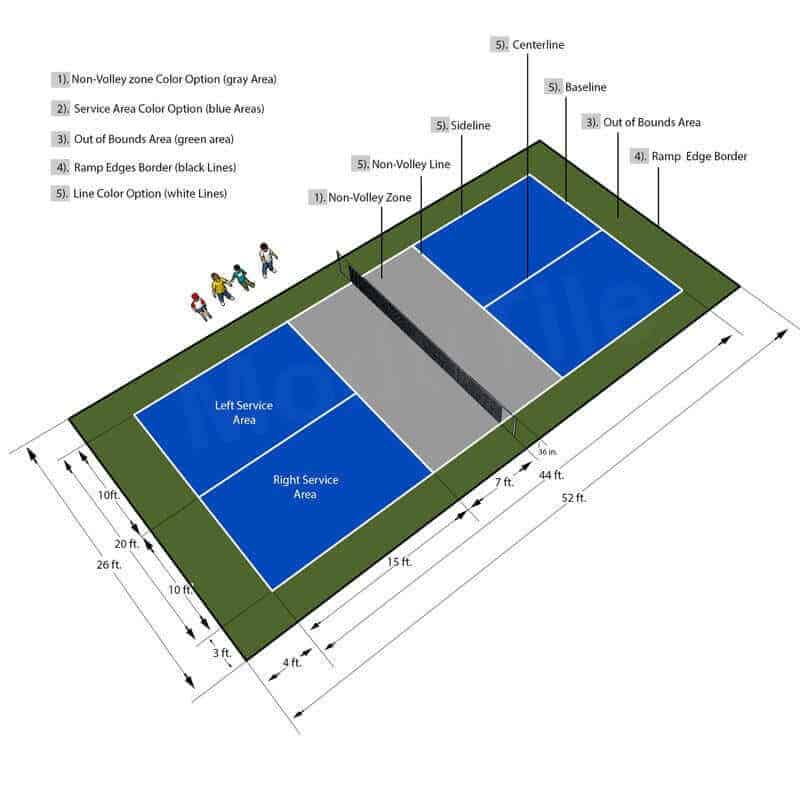Technologies in Pickleball Court Construction: Trends You Need To Know
Navigating Laws for Pickleball Court Building in Your Location
Building a pickleball court in your area needs a nuanced understanding of different local regulations, including zoning laws, structure authorizations, and safety and security requirements. Engaging with local authorities and the community is critical for ensuring conformity and fostering assistance.
Comprehending Local Zoning Legislations
When thinking about the construction of a pickleball court, understanding regional zoning laws is vital to making sure compliance and avoiding potential lawful issues. Zoning policies dictate just how land can be made use of and often consist of specs related to recreational centers. These laws can vary considerably by municipality, influencing factors such as court placement, size, sound, and lights degrees.
Prior to initiating building and construction, it is vital to consult the regional zoning board or planning department to ascertain the certain guidelines that apply to your property. Specific areas might limit recreational activities, while others might call for particular permits or adherence to particular standards. It is also essential to consider setbacks, which identify exactly how far frameworks have to be from building lines or other structures.
In addition, exclusive developments, such as property owner associations (HOAs), might impose their own regulations relating to the building and use pickleball courts. Understanding these policies can protect against expensive modifications or lawsuits down the line. Involving with neighborhood stakeholders and area participants can give valuable insights and foster support for your project, guaranteeing that it straightens with the area's needs and expectations.
Obtaining Necessary Structure Permits
How does one browse the intricacies of acquiring necessary building authorizations for a pickleball court? Typically, you will require to submit a comprehensive site strategy that details the recommended court measurements, products, and layout.

Once permits are acquired, it is essential to follow any type of assessment timetables and needs throughout the building stage. Keeping communication with regional authorities will certainly facilitate a smoother authorization procedure and help prevent prospective problems. By thoroughly preparing and recognizing the allowing landscape, you can successfully browse the intricacies involved in building a pickleball court while staying certified with all local guidelines.

Assessing Environmental Impact
A comprehensive evaluation of ecological effect is important when preparing the building and construction of a pickleball court. This evaluation helps determine prospective results on regional ecological communities, water resources, and neighborhood aesthetic appeals. Secret elements to take into consideration include website option-- guaranteeing that the court is not developed on ecologically sensitive land, such as marshes or environments for endangered species
Soil stability and drainage patterns should be examined to stop disintegration and water pooling, which might negatively affect surrounding vegetation and wildlife. Additionally, the choice of materials is essential; choosing eco-friendly and lasting alternatives lessens environmental harm.
The application of efficient stormwater administration methods is an additional essential element, as it assists alleviate overflow and sedimentation. Engaging with local ecological firms can supply useful understandings right into laws and ideal techniques certain to your location.
Finally, community input can be advantageous in comprehending any kind of neighborhood environmental concerns and fostering assistance for the job. By performing a comprehensive environmental impact analysis, stakeholders can make certain that pickleball court building lines up with sustainable techniques and adds favorably to the neighborhood's eco-friendly health and wellness.
Abiding By Safety Specifications
Guaranteeing compliance with safety and security standards is critical for the effective building and operation of a pickleball court. Sticking to well established safety regulations minimizes the threat of mishaps and injuries, making sure a safe and secure environment for gamers.
Trick safety criteria i loved this include correct court measurements, surface products, and lighting demands. The court needs to meet the official measurements of 20 feet broad by 44 feet long over at this website for doubles play, with proper barrier zones to stop injuries from errant rounds. Pickleball court construction. The surface area should be built from non-slip products to enhance traction and minimize the likelihood of falls
In addition, lighting has to suffice for night play, giving uniform lighting to prevent darkness that can prevent visibility. Local building ordinance may likewise determine details needs for fencing and net elevation to guarantee gamer security and avoid unauthorized accessibility to the court location.
Normal examinations and maintenance are vital to maintain these requirements with time. By focusing on safety and security compliance, court proprietors not only protect players yet likewise cultivate a favorable credibility within the neighborhood. This commitment to security can urge greater engagement and pleasure of the sporting activity, eventually adding to its growth and sustainability.

Involving the Neighborhood in Preparation
Neighborhood participation in the drawing board of pickleball court building and construction can significantly improve the task's overall success. Involving local residents and stakeholders cultivates a sense of possession and motivates collaborative decision-making, which can bring about more comprehensive support for the effort.
To properly entail the neighborhood, coordinators should initiate public conferences or workshops, supplying a platform for locals to articulate their opinions and preferences pertaining to area, design, and amenities. Surveys and responses kinds can additionally be utilized to gather understandings from a bigger target market, ensuring that varied viewpoints are taken into consideration.
In addition, developing an area board of advisers can promote continuous conversations and address issues throughout the preparation process. This board can include reps from numerous demographics, such as regional colleges, entertainment companies, and neighborhood associations, thus amplifying neighborhood representation.
Efficient communication is vital; updates concerning the job need to be regularly shared via e-newsletters, social media, or local bulletins. By prioritizing community interaction, organizers can grow enthusiasm, reduce possible resistance, and produce a pickleball center that really reverberates with local values and see here now requirements. This collaborative approach not only enriches the job however also enhances community connections.
Final Thought
In verdict, browsing the intricacies of pickleball court building and construction requires a thorough understanding of neighborhood policies, consisting of zoning legislations, building authorizations, and safety and security requirements. Conducting environmental evaluations is necessary to reduce environmental influence, while area involvement can enhance assistance for such jobs. By sticking to these standards and promoting partnership, successful application of pickleball courts can be attained, promoting entertainment possibilities and neighborhood well-being. Proceeded diligence in these areas will certainly make sure compliant and sustainable development.
Building a pickleball court in your area requires a nuanced understanding of various local guidelines, including zoning legislations, building authorizations, and safety and security standards.When taking into consideration the construction of a pickleball court, recognizing local zoning legislations is essential to making sure conformity and preventing possible legal problems. By thoroughly preparing and understanding the permitting landscape, you can efficiently browse the complexities included in constructing a pickleball court while staying certified with all regional laws.
In final thought, browsing the complexities of pickleball court construction requires a comprehensive understanding of neighborhood policies, including zoning regulations, structure licenses, and safety and security standards. By adhering to these guidelines and promoting partnership, effective application of pickleball courts can be accomplished, advertising leisure chances and community health.